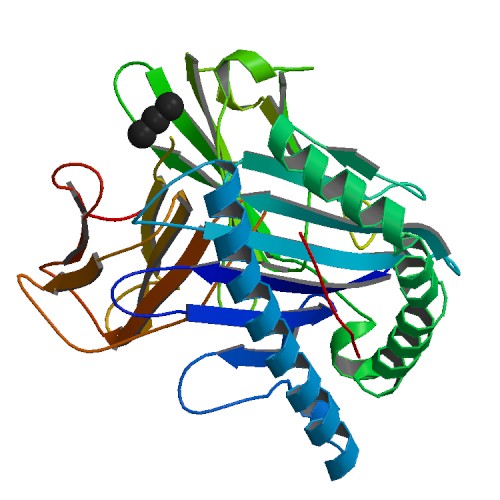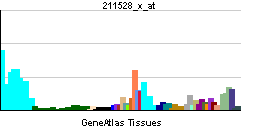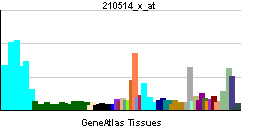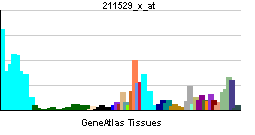HLA-G
| HLA-G histocompatibility antigen, class I, G | |||||||||||||
|---|---|---|---|---|---|---|---|---|---|---|---|---|---|
 PDB rendering based on 1ydp. | |||||||||||||
| |||||||||||||
| Identifiers | |||||||||||||
| Symbols | HLA-G ; MHC-G | ||||||||||||
| External IDs | Template:OMIM5 Template:MGI HomoloGene: 83263 | ||||||||||||
| |||||||||||||
| RNA expression pattern | |||||||||||||
 | |||||||||||||
 | |||||||||||||
 | |||||||||||||
| More reference expression data | |||||||||||||
| Orthologs | |||||||||||||
| Template:GNF Ortholog box | |||||||||||||
| Species | Human | Mouse | |||||||||||
| Entrez | n/a | n/a | |||||||||||
| Ensembl | n/a | n/a | |||||||||||
| UniProt | n/a | n/a | |||||||||||
| RefSeq (mRNA) | n/a | n/a | |||||||||||
| RefSeq (protein) | n/a | n/a | |||||||||||
| Location (UCSC) | n/a | n/a | |||||||||||
| PubMed search | n/a | n/a | |||||||||||
HLA-G histocompatibility antigen, class I, G, also known as HLA-G, or Human Leukocyte Antigen G, is a human gene.
HLA-G belongs to the HLA nonclassical class I heavy chain paralogues. This class I molecule is a heterodimer consisting of a heavy chain and a light chain (beta-2 microglobulin). The heavy chain is anchored in the membrane. HLA-G is expressed on fetal derived placental cells. The heavy chain is approximately 45 kDa and its gene contains 8 exons. Exon one encodes the leader peptide, exons 2 and 3 encode the alpha1 and alpha2 domain, which both bind the peptide, exon 4 encodes the alpha3 domain, exon 5 encodes the transmembrane region, and exon 6 encodes the cytoplasmic tail.[1]
References
Further reading
- Arnaiz-Villena A, Martinez-Laso J, Alvarez M; et al. (1997). "Primate Mhc-E and -G alleles". Immunogenetics. 46 (4): 251–66. PMID 9218527.
- Le Bouteiller P (2000). "HLA-G in the human placenta: expression and potential functions". Biochem. Soc. Trans. 28 (2): 208–12. PMID 10816129.
- Geyer M, Fackler OT, Peterlin BM (2001). "Structure--function relationships in HIV-1 Nef". EMBO Rep. 2 (7): 580–5. doi:10.1093/embo-reports/kve141. PMID 11463741.
- Langat DK, Hunt JS (2003). "Do nonhuman primates comprise appropriate experimental models for studying the function of human leukocyte antigen-G?". Biol. Reprod. 67 (5): 1367–74. PMID 12390864.
- Moreau P, Dausset J, Carosella ED, Rouas-Freiss N (2003). "Viewpoint on the functionality of the human leukocyte antigen-G null allele at the fetal-maternal interface". Biol. Reprod. 67 (5): 1375–8. PMID 12390865.
- Moreau P, Rousseau P, Rouas-Freiss N; et al. (2002). "HLA-G protein processing and transport to the cell surface". Cell. Mol. Life Sci. 59 (9): 1460–6. PMID 12440768.
- Greenway AL, Holloway G, McPhee DA; et al. (2004). "HIV-1 Nef control of cell signalling molecules: multiple strategies to promote virus replication". J. Biosci. 28 (3): 323–35. PMID 12734410.
- Bénichou S, Benmerah A (2003). "[The HIV nef and the Kaposi-sarcoma-associated virus K3/K5 proteins: "parasites"of the endocytosis pathway]". Med Sci (Paris). 19 (1): 100–6. PMID 12836198.
- Le Bouteiller P, Legrand-Abravanel F, Solier C (2004). "Soluble HLA-G1 at the materno-foetal interface--a review". Placenta. 24 Suppl A: S10–5. PMID 12842408.
- Sköld M, Behar SM (2003). "Role of CD1d-restricted NKT cells in microbial immunity". Infect. Immun. 71 (10): 5447–55. PMID 14500461.
- Wiendl H, Mitsdoerffer M, Weller M (2004). "Express and protect yourself: the potential role of HLA-G on muscle cells and in inflammatory myopathies". Hum. Immunol. 64 (11): 1050–6. PMID 14602235.
- Urosevic M, Dummer R (2004). "HLA-G in skin cancer: a wolf in sheep's clothing?". Hum. Immunol. 64 (11): 1073–80. PMID 14602238.
- Carosella ED, Moreau P, Le Maoult J; et al. (2004). "HLA-G molecules: from maternal-fetal tolerance to tissue acceptance". Adv. Immunol. 81: 199–252. PMID 14711057.
- Leavitt SA, SchOn A, Klein JC; et al. (2004). "Interactions of HIV-1 proteins gp120 and Nef with cellular partners define a novel allosteric paradigm". Curr. Protein Pept. Sci. 5 (1): 1–8. PMID 14965316.
- Le Maoult J, Rouas-Freiss N, Le Discorde M; et al. (2004). "[HLA-G in organ transplantation]". Pathol. Biol. 52 (2): 97–103. doi:10.1016/j.patbio.2003.04.006. PMID 15001239.
- Tolstrup M, Ostergaard L, Laursen AL; et al. (2004). "HIV/SIV escape from immune surveillance: focus on Nef". Curr. HIV Res. 2 (2): 141–51. PMID 15078178.
- Joseph AM, Kumar M, Mitra D (2005). "Nef: "necessary and enforcing factor" in HIV infection". Curr. HIV Res. 3 (1): 87–94. PMID 15638726.
- McIntire RH, Hunt JS (2005). "Antigen presenting cells and HLA-G--a review". Placenta. 26 Suppl A: S104–9. doi:10.1016/j.placenta.2005.01.006. PMID 15837058.
- Anderson JL, Hope TJ (2005). "HIV accessory proteins and surviving the host cell". Current HIV/AIDS reports. 1 (1): 47–53. PMID 16091223.
| This protein-related article is a stub. You can help Wikipedia by expanding it. |